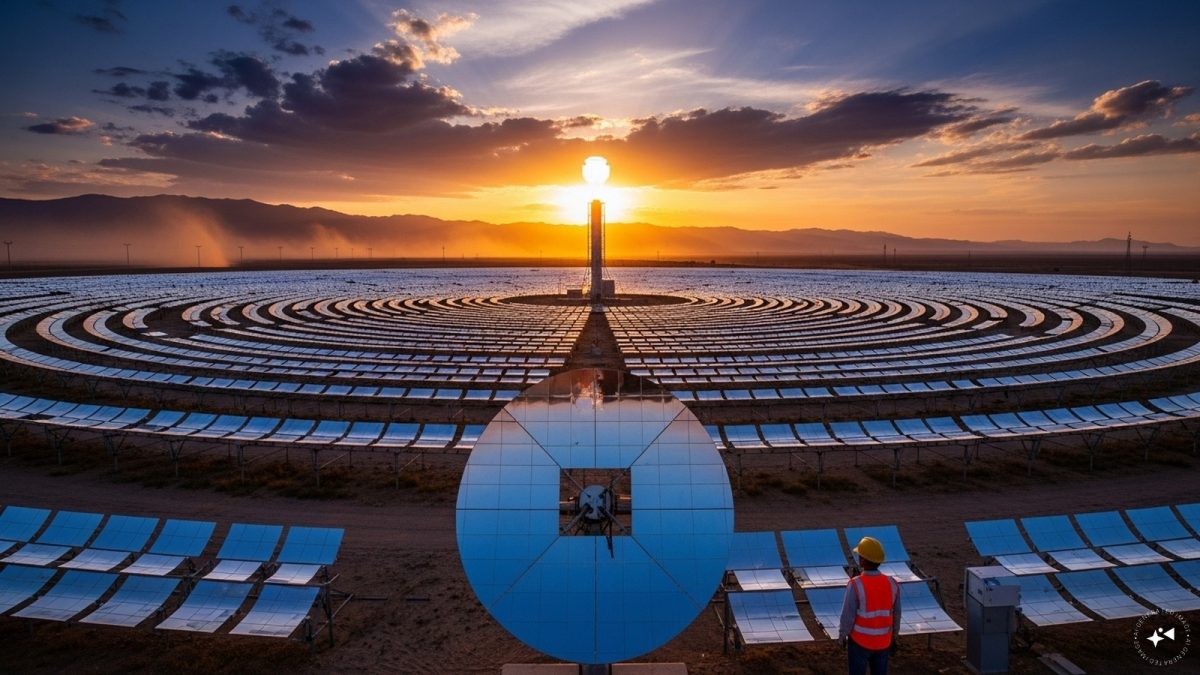China has flicked the switch on the world’s first dual-tower solar thermal power station, a milestone in renewable energy engineering and showcasing Beijing’s growing technological prowess in clean power generation. The state-of-the-art facility, located in the vast expanse of the Gobi Desert brings together innovation, scale and precision to harness the sun’s heat like never before.
A world-first in solar innovation
The newly commissioned plant in Guazhou County in northwestern Gansu province is unlike any solar project built before. It uses two solar towers feeding a single turbine system, an arrangement never previously achieved anywhere in the world.
Nearly 27,000 mirrors, known as heliostats, have been installed in the desert to track and reflect sunlight onto the two 200-metre-high (656 feet) towers. These towers are placed about 1 kilometre (0.62 miles) apart and work in tandem to concentrate solar energy on receivers located at their summits.
The heat generated, reaching temperatures high enough to melt metal, is used to produce steam that drives a central turbine, generating electricity without burning fossil fuels. This dual-tower configuration enables more efficient use of sunlight, reduced energy loss, and greater operational flexibility compared to conventional single-tower systems.
How the technology works
Unlike photovoltaic (PV) systems, which convert sunlight directly into electricity using solar panels, solar thermal plants concentrate sunlight to create heat energy, which is then converted into power.
At Guazhou, each of the 27,000 mirrors is computer-controlled to precisely follow the sun’s trajectory throughout the day. The concentrated sunlight heats molten salt stored in receivers at the top of the towers to temperatures exceeding 500°C.
This molten salt serves as both a heat-transfer and energy-storage medium, allowing the plant to continue producing electricity even after sunset — one of the biggest limitations of traditional solar farms.
By combining two towers with a single turbine, engineers have been able to increase efficiency, reduce costs, and create a more resilient system that can operate continuously with minimal downtime.
Impact Shorts
More ShortsBuilt in the Gobi Desert’s harsh environment
The Gobi Desert, spanning northern China and southern Mongolia, offers ideal conditions for such a project: vast open land, high solar irradiance, and minimal rainfall. However, these advantages come with challenges such as extreme temperature fluctuations, strong winds and dust storms that can obscure sunlight and damage delicate optics.
To overcome these, Chinese engineers have equipped the site with automated cleaning systems for the mirrors and advanced tracking algorithms that adjust for atmospheric conditions.
The plant’s designers say that locating it in Guazhou also helps stabilise the regional power grid by providing consistent renewable energy to the northwestern provinces, traditionally dependent on coal.
A strategic step in China’s green ambitions
The solar thermal station is part of China’s broader “energy revolution”, a national effort to reduce carbon emissions and strengthen energy security through renewables. The country, the world’s largest carbon emitter aims to reach carbon neutrality by 2060 and to have over 80% of its energy mix from non-fossil sources by mid-century.
By developing advanced solar thermal technologies, China is diversifying its renewable portfolio beyond wind and photovoltaic systems. Experts say thermal plants offer an edge because they provide “dispatchable” renewable power, meaning electricity can be generated on demand, unlike the intermittent nature of sunlight or wind.
According to the South China Morning Post, the Guazhou project demonstrates Beijing’s commitment to scaling up high-efficiency, long-duration energy storage — key to stabilising renewable grids worldwide.
Engineering a new benchmark
Globally, only a handful of large-scale solar thermal plants exist in the United States, Spain and the Middle East. Yet none use the dual-tower, single-turbine configuration now pioneered by China.
This system not only improves energy capture but also minimises maintenance and enhances grid reliability. Analysts say it could become a blueprint for future solar developments, particularly in sun-rich but energy-hungry regions like Africa, the Middle East and South Asia.
By achieving this breakthrough, China has once again positioned itself at the forefront of renewable innovation, complementing its dominance in solar PV manufacturing and battery technology.
A glimpse into the future
As nations race to meet net-zero goals, China’s dual-tower solar thermal plant signals a technological shift in how the world approaches sustainable energy generation. With further advancements, similar plants could play a key role in balancing renewable grids, providing round-the-clock power without fossil fuels.
For now, the shimmering field of 27,000 mirrors in the Gobi Desert stands as a symbol of human ingenuity and a reminder that the race to harness the sun’s full potential is only just beginning.
)